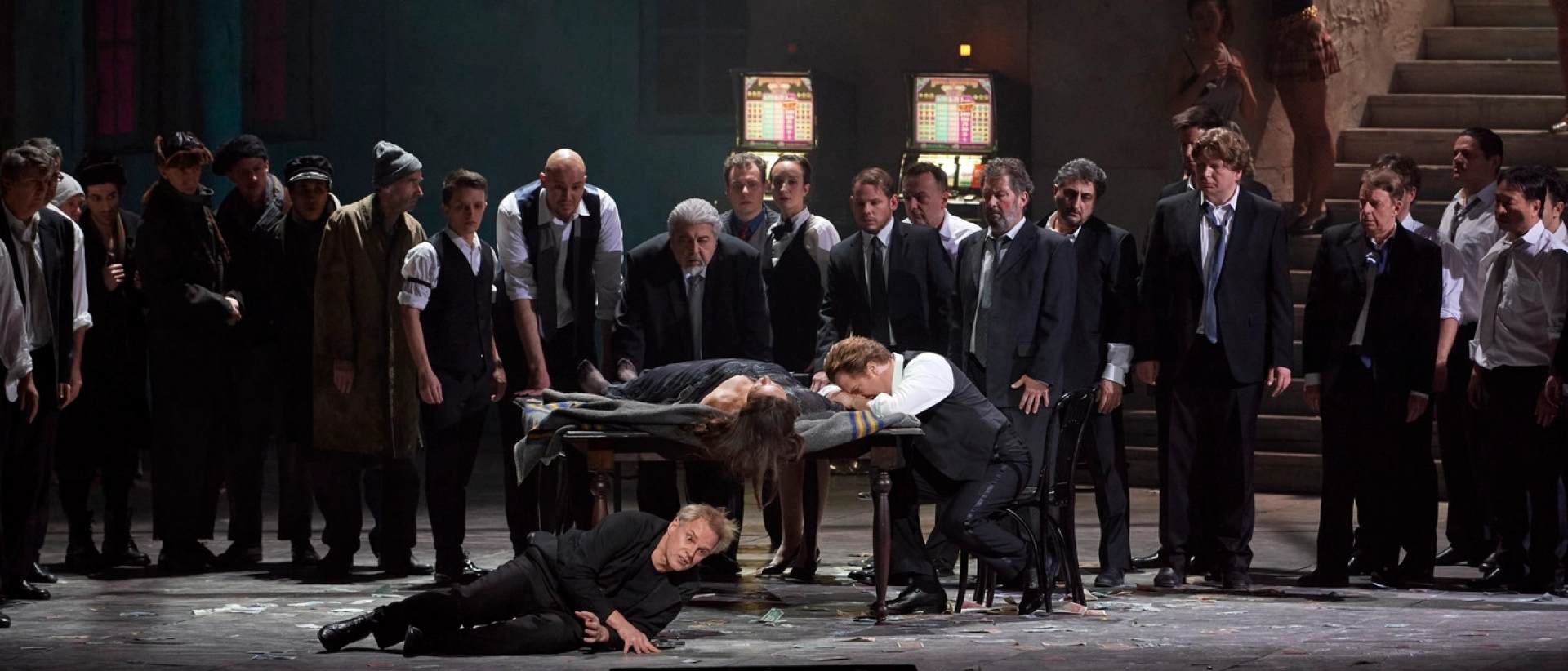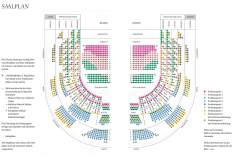Pique Dame
Mo | Tu | We | Th | Fr | Sa | Su |
Synopsis
ACT 1
A spring day in St. Petersburg. Nannies and governesses supervise the children entrusted to them. The outsider Hermann confesses to Tomski his desperate love for a stranger whom he only idolizes from afar.
Tomski tries to encourage Hermann, but is ridiculed by Chekalinsky and Surin. When Prince Yeletsky appears and introduces his fiancée Lisa, Hermann recognizes his beloved stranger in her. Lisa's grandmother, the old countess and so-called "Queen of Spades", appears at her side. She is both fascinated and repelled by Hermann's appearance - just as he is by hers.
Tomski tells the story behind the old countess's nickname: as a young woman, she caused a sensation in Paris as the "Muscovite Venus". After she had gambled away her entire fortune, the Count of Saint Germain sold her the secret of three infallible cards for the price of a night of love. The countess regained her fortune.
She only confided the secret to her husband and one lover. A ghost has prophesied that a third lover, to whom she will reveal the three cards, will cause her death.
The penniless Hermann, who watches the game of chance with fascination all night long but does not take part himself, is teased by Tschekalinski and Surin: As the old countess's lover, he could afford to take part in the game.
Lisa says goodbye to her friends before the wedding. Polina sings a melancholy romance, then they dance until Lisa's governess forbids these pleasures.
When Lisa is alone, her repressed feelings for Hermann catch up with her. Suddenly he himself stands before her and threatens to commit suicide out of unrequited love. The old countess appears and Hermann has to go into hiding. When Lisa and Hermann are alone again, she confesses her love for him.
ACT 2
The play The Sincerity of the Shepherdess is performed as part of Lisa's engagement celebrations with Prince Yeletsky.
Unlike the shepherdess shown, Lisa has not chosen her love for a have-not, but a life of wealth.
Hermann's comrades frighten, unsettle and mock him with continued allusions to the old countess.
Lisa manages to elude Prince Yeletsky and slips Hermann a key which leads him through the countess's bedroom to her room. He announces his visit for the same night.
Hermann's imagination falls more and more under the spell of the "Muscovite Venus". He surprises and harasses the old countess, in whose mind memories of her glory days at the French court mingle with the presence of Hermann, who is passionately courting her secret. She dies in Hermann's arms without having revealed the secret. Lisa, who rushes over, realizes that Hermann was less interested in her than in the secret of the three cards.
ACT 3
Hermann, whose hopes have been dashed by the death of the countess, is haunted by feverish fantasies.
At its peak, the ghost of the old countess appears, tells him to marry Lisa and teaches him the three infallible cards three, seven and ace.
Lisa has given Hermann an ultimatum: If he does not come to her by midnight, she will consider him her grandmother's murderer.
Hermann appears shortly after midnight to take her to the gambling parlor. She recognizes his obsession and takes her own life.
Hermann surprises the players with his desire to take part. He bets an exorbitant sum and wins with the three, only to double his winnings with the seven in the next round. No one wants to compete against him. Then Prince Yeletsky appears, who has come to take revenge on Hermann for Lisa's loss. Hermann loses because he bets on the queen pique instead of the ace.
ACT 1 & 2 - 95 MIN
INTERMISSION - 25 MIN
ACT 3 - 80 MIN
Program and cast
Hermann: Yusif Eyvazov
Tomski and Pluto: Alexey Markov
Jeletzki: Boris Pinkhasovich
Countess: Elena Zaremba
Lisa: Anna Netrebko
Polina and Daphnis: Elena Maximova
Conductor: Timur Zangiev
Director: Vera Nemirova
Stage: Johannes Leiacker
Costumes: Marie-Luise Strandt
Vienna State Opera
Public Transport
Subway lines: U1, U2, U4
Trams: 1, 2, D, J, 62, 65
Buses: 59A
Local Railway: Badner Bahn
Stops: Karlsplatz / Opera
Taxi stands are available nearby.
Parking
Parking is only € 6, - for eight hours!
The Wiener Staatsoper and the ÖPARK Kärntner Ring Garage on Mahlerstraße 8, under the “Ringstraßengalerien”, offer the patrons of the Vienna State Opera a new, reduced parking fee. You can park in the Kärntner Ring Garage for up to 8 hours and pay only a flat fee of € 6, -. Just validate your ticket at one of the discount machines inside the Wiener Staatsoper. The normal rate will be charged for parking time greater than 8 hours. The validation machines can be found at the following coat checks: Operngasse, Herbert von Karajan-Platz, and the right and left and balcony galleries.
Important: In order to get the discount, please draw a ticket and do not use your credit card when entering the garage!
After devaluing your ticket in the Wiener Staatsoper you can pay comfortably by credit card or cash at the vending machines.
The machines accept coins and bills up to 50.- Euro. Parking time longer than 8 hours will be charged at the normal rate.
History
The structure of the opera house was planned by the Viennese architect August Sicard von Sicardsburg, while the inside was designed by interior decorator Eduard van der Nüll. It was also impacted by other major artists such as Moritz von Schwind, who painted the frescoes in the foyer, and the famous "Zauberflöten" (“Magic Flute”) series of frescoes on the veranda. Neither of the architects survived to see the opening of ‘their’ opera house: the sensitive van der Nüll committed suicide, and his friend Sicardsburg died of a stroke soon afterwards.
On May 25, 1869, the opera house solemnly opened with Mozart's Don Giovanni in the presence of Emperor Franz Joseph and Empress Elisabeth.
The popularity of the building grew under the artistic influence of the first directors: Franz von Dingelstedt, Johann Herbeck, Franz Jauner, and Wilhelm Jahn. The Vienna opera experienced its first high point under the direction of Gustav Mahler. He completely transformed the outdated performance system, increased the precision and timing of the performances, and also utilized the experience of other noteworthy artists, such as Alfred Roller, for the formation of new stage aesthetics.
The years 1938 to 1945 were a dark chapter in the history of the opera house. Under the Nazis, many members of the house were driven out, pursued, and killed, and many works were not allowed to be played.
On March 12, 1945, the opera house was devastated during a bombing, but on May 1, 1945, the “State Opera in the Volksoper” opened with a performance of Mozart's THE MARRIAGE OF FIGARO. On October 6, 1945, the hastily restored “Theaters an der Wien” reopened with Beethoven's FIDELIO. For the next ten years the Vienna State Opera operated in two venues while the true headquarters was being rebuilt at a great expense.
The Secretary of State for Public Works, Julius Raab, announced on May 24, 1945, that reconstruction of the Vienna State Opera would begin immediately. Only the main facade, the grand staircase, and the Schwind Foyer had been spared from the bombs. On November 5, 1955, the Vienna State Opera reopened with a new auditorium and modernized technology. Under the direction of Karl Böhm, Beethoven’s FIDELIO was brilliantly performed, and the opening ceremonies were broadcast by Austrian television. The whole world understood that life was beginning again for this country that had just regained its independence.
Today, the Vienna State Opera is considered one of the most important opera houses in the world; in particular, it is the house with the largest repertoire. It has been under the direction of Dominique Meyer since September 1, 2010.

 EN
EN DE
DE IT
IT FR
FR ES
ES RU
RU JP
JP RO
RO
 Seating plan
Seating plan